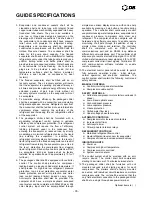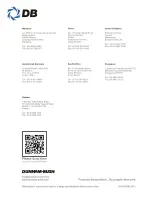
- 32 -
APPLICATION DATA
HEAT RECOVERY
The Dunham-Bush Water Cooled Screw Flooded Chiller
can significantly reduce building operating costs when the
heat recovery option is selected. Any building which
requires simultaneous heating and cooling may be an
excellent candidate for this system.
Hotter Hot Water
Most centrifugal water chillers are limited in producing
leaving condenser water temperatures to 105°F or below.
Dunham-Bush Water Cooled Screw Flooded Chillers are
able to provide leaving water temperatures over 120°F
allowing for the installation of smaller heating coils at a
lower first cost than systems utilizing centrifugal water
chillers. The warmer supply air temperatures available
will also improve tenant comfort.
Greater Design Flexibility
Centrifugal water chillers are susceptible to surge
conditions during part-load operation and need to be
selected to operate in a narrow operating envelope. The
heat recovery Dunham-Bush Water Cooled Screw
Flooded Chiller, on the other hand, utilizes a positive
displacement compressor which will not surge. This
chiller is capable of unloading its compressors to their
minimum capacity at all head conditions, both cooling and
heat recovery, for greater design flexibility. The unit can
be modified for Heat Reclaim use.
Lower Energy Consumption
The efficient unloading characteristics of the Dunham-
Bush Water Cooled Screw Flooded Chiller compressor
make it ideal for heat recovery duty. Heat recovery
chillers must be selected to operate at many operating
conditions, not just full load heating and full load cooling
duties. Heat recovery chillers spend the majority of their
time at lower loads, conditions at which centrifugal
chillers must often be operating with energy inefficient hot
gas bypass.
Free Cooling Not Free Heating
Even greater energy savings can be achieved when the
Dunham-Bush Rotary Screw Water Cooled Heat
Recovery Chillers are utilized to their maximum benefit.
Typically heat recovery chillers had been thought to
supply "free heat" while cooling a constant load within a
building. The higher head conditions for heat recovery
however cause the compressor to draw more power than
for cooling only duty. The ideal way to utilize a heat
recovery chiller would be to have it operate at only
the capacity required for the variable-heating load. This
would enable the remainder of the base-cooling load to
be handled by a separate chiller utilizing evaporator
entering condensing water temperatures and greater
energy efficiency. Unfortunately, centrifugal chillers do
not have the ability to operate at lower percent loads
enabling them to satisfy only the heating load required.
As a result, centrifugal heat recovery chillers have
typically been operating and satisfying the base cooling
load and utilizing only a portion of the recoverable heat to
satisfy the variable building-heating load. Dunham-Bush
Rotary Screw Compressor characteristics, on the other
hand, allow the heat recovery chiller to unload to very low
load capacities at the high head conditions created in
heat recovery operation. To utilize the Dunham-Bush
Rotary Screw Heat Recovery Chillers to their fullest
potential, the designer must change his way of thinking to
providing chillers that are unloaded to provide only the
heating load required and simultaneously supply a portion
of free cooling to cover the base cooling load.
Controls
Units can also be provided with optional dual controls so
they can control leaving chilled water or leaving
condenser water. A dual bundle condenser is provided on
a Heat Recovery Water Chiller which minimizes space
requirements. Consult your local Dunham-Bush Sales
Representative for additional details.
Head Pressure Control
Cooling tower control is increasingly becoming an
overlooked subject, and it causes problems. The
following is a general recommendation that is applicable
to all standard packaged chillers.
Virtually all chiller manufacturers recommend that
condenser water be controlled so that its temperature
never goes below 60°F (even when the machine is off)
and that its rate of change is not rapid. Rapid can be
defined as not exceeding 2°F per minute. This is
necessary because a chiller operates in a dynamic
environment and is designed to maintain a precise
leaving chilled water temperature under varying entering
conditions. The additional dynamic of rapidly varying
condenser water temperature subjects the machine to
fluctuating pressure differentials across the evaporator
and condenser. This varies the refrigerant flow and,
therefore, the capacity. If this occurs faster than the
machine can accommodate it, the head pressure or
suction pressure will soon exceed their safety setpoints
and the machine will shut down.
Содержание WCFX-E Series
Страница 27: ...27 TYPICAL WIRING SCHEMATIC Two Compressors Unit...
Страница 28: ...28 TYPICAL WIRING SCHEMATIC...
Страница 29: ...29 TYPICAL WIRING SCHEMATIC...
Страница 30: ...30 TYPICAL WIRING SCHEMATIC...
Страница 31: ...31 TYPICAL WIRING SCHEMATIC...
Страница 36: ......



















